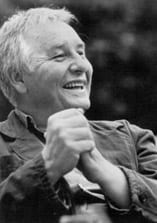The Symphony No. 4 of Henryk Mikołaj Górecki was given its World Premiere on April 12 at the Royal Festival Hall in London. The London Philharmonic Orchestra was conducted by Andrey Boreyko. This posthumously-premiered work was commissioned by the London Philharmonic Orchestra, with generous support from the Adam Mickiewicz Institute, and the Los Angeles Philharmonic Association and Zaterdag Matinee Amsterdam. It will be presented again by the Los Angeles Philharmonic and at the Zaterdag Matinee concert series in Amsterdam during the 2015/2016 season.
Written for orchestra, organ and piano, Górecki’s Fourth bears the subtitle Tansman Episody, and was inspired by Andrzej Wendland, the organizer of the Aleksander Tansman Festival in Łódź. Its premiere was originally scheduled for April 2010 at the Royal Festival Hall’s Polish Year Festival, but Górecki was unable to finish the work due to ill health. After his death, the score was orchestrated by Górecki’s son, Mikołaj, according to the book recently published by PWM, Górecki. Portret w pamięci[Górecki, A Portrait from Memory].
The April 12 premiere elicited much positive press coverage, especially in England, several examples of which are listed below.
Ben Lawrence, writing for The Telegraph, stated:
Those expecting the serenity of [Górecki’s] Third may have been disappointed, but this swansong turned out to be extraordinary: playful, dramatic and tender.” Summarizing the concert, Mr. Lawrence decreed Górecki’s Fourth, “… an ambitious, hypnotic work,” adding that the work “… acts as a meditation by Górecki on the many styles he adopted and developed during a long and successful career.
Another web review at www.thesprout.co.uk related:
Goosebumps and tears abound for the opening and closing, as brass, drums and organ deliver terrifying and positively electrifying repeated chords. The noise here was almost verging on a sort of oriental music.
The string writing is certainly not as moving as in [Górecki’s] Third, but an intimate duet for cello and piano evokes the same as in Messiaen’s Quartet for the End of Time. Bizarre circus-like music even finds its way into this work, framing the said cello number. It is certainly a well-played juxtaposition on the composer’s behalf. I’d like to think that the audience enjoyed it. Some would have been shocked by it (a handful walked out). Many people giving ovations and a mass of applause. Conductor Andrey Boreyko (who was stellar all evening), very touchingly placed a bouquet of flowers he was handed onto the sheet music for the work, in a tribute to Górecki. An image to stay with me for some time…
Writing for The Guardian, George Hall focused on the emotional impact of the work, stating:
Massive and violently contrasting blocks of ideas dominate the four-movement, 40-minute span; multiple repetitions of the opening chordal sequence, interspersed by almighty blows on three bass drums, are characteristic. (Verdi needed just one for his Dies Irae.) An expressive solo cello, later joined by a violin, both floated over a soft piano accompaniment, form the still chamber-like centre of the otherwise manically vigorous scherzo. The extremity of such individual ideas and the replacement of any sense of development by sheer repetition give the Symphony a rough-hewn, monumental feel.
[Sources: pwm.com.pl, telegraph.co.uk, thesprout.co.uk, theguardian.com]
